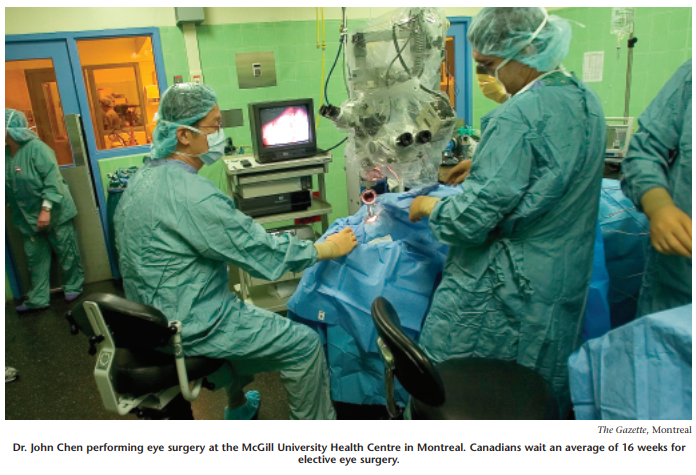
Obama is beginning to understand that reforming the US health care system is a lot harder than winning the war in Afghanistan.
Michael Decter,
Canadian health care policy guru
A nation that spends one dollar out of five on drugs and doctors is not healthy. Within a decade that will be America’s fate. A society that spends nearly half of every public dollar on treating the sick and dying is robbing its children’s future as well. That’s how unhealthy most Canadian provinces are today.
These are the hard truths beneath all the noise about who pays for health care in the United States. Whether taxpayers, employers or families fund health care matters. That each nation is being driven into record deficits by an ailing medical system matters more.
We have one advantage over the Americans: Canadian governments realized the health care bathtub was about to overflow and began the struggle to “bend the cost curve” years ago. An enormous amount of effort has led to some early successes. We are, so far, no closer to stopping the runaway costs of the health care train.
Americans are further in the hole — they spend twice as much per capita as we do for a system that doesn’t even cover more than 40 million Americans. Even though they spend nearly 18 percent of GDP and we spend about half that, the cost spiral is unsustainable for both countries. How much of that amazing cost gap can be attributed to the differences between our systems — each a mix of public and private providers? Much of it, according to experts on both sides. But some of the reasons the US spends more to get less coverage relate to differences entirely outside the health care system.
One American study attributed nearly half of 1 percent of health care spending — many billions of dollars in costs — to guns. US big-city hospital emergency rooms are full of young men with serious gunshot wounds, many requiring expensive and long-term treatment, and most of the victims are uninsured young men and therefore unfunded costs for everyone else. Compounding that sad cost is that poor people are more likely to be both uninsured and in bad health. America has greater social inequality and a higher percentage of poor uninsured health care users than does Canada. Bizarrely, as his final contribution to a series of attacks on the Canadian system, US Senate Republican leader Mitch McConnell explained that the reason Canadians live on average five years longer than Americans has nothing to do with the quality of our health care in comparison with theirs. The difference, in Ontario, he explained, was entirely due to the province’s poor showing in deaths by gunshot wounds, a ranking in which his state of Kentucky performed especially well. This head-snapping defence by the senator was his final riposte in an attack on the wait times at Kingston General Hospital (KGH). He used the highly respected Ontario hospital as an icon of all that’s wrong with the Canadian system.
His researchers should be fired, as he could not have chosen a less apt comparison. Canadian senator Hugh Segal, in a typically wry but robust defence, pointed out that as a fellow conservative who is concerned about wasteful public expenditure, the good senator might better be concerned that KGH, along with the rest of the Canadian system, delivered longer life, better health at half the price of American system. This provoked the sneer about our poor gunshot performance.
Americans are further in the hole — they spend twice as much per capita as we do for a system that doesn’t even cover more than 40 million Americans. Even though they spend nearly 18 percent of GDP and we spend about half that, the cost spiral is unsustainable for both countries. How much of that amazing cost gap can be attributed to the differences between our systems — each a mix of public and private providers?
The Kingston hospitals are also pioneers in how doctors are compensated and leaders in shifting professional behaviour from “fee maximization” to improving productivity and patient outcomes. For more than 15 years, KGH, its two Kingston partner hospitals and the Queen’s medical school have managed a joint budget from the province based on overall performance goals, not on individual budgets or compensation. Other hospitals in the province have begun to adopt similar systems. When a fully implemented electronic health record system allows, this alternative compensation foundation will permit serious efforts to improve health and quality of life, patient by patient, and to reduce costs.
The United Kingdom is far ahead of Canada already in tying spending to performance. Under its community-clinic-based system, and as a result of the performance-tested hospital budget system imposed by the Blair government, each year as much as 45 percent of the compensation of many British GPs is “at risk.” Like everyone else though, the Brits have not been able to bend their cost curve any better than has Canada or United States. As one frustrated medical expert put it, “Just because you can deliver better outcomes, move patients through the system faster and do better tracking over time doesn’t reduce your system costs. There is always a line of patients willing to fill that bed no matter how quickly you empty it.”
Beyond guns and weak performance measurement, there is a long list of reasons why American health care costs more and delivers less. At the top of most experts’ lists is the cost of private health insurance administration, including efforts to deny service and/or cut benefits, and marketing. The cost of litigation, malpractice and the unnecessary tests and procedures required by the “defensive medicine” they create is usually second. The absence of a powerful single payer — which in our case is the provincial governments — reduces health care buyers’ bargaining leverage in the US. As a result, virtually everything, from drugs to hospital beds to toilet paper, is more expensive in the US system than it is in the Canadian one. Next comes the cost of specialization. More than two-thirds of US doctors are specialists: that is where the money is. In Canada, nearly half of our doctors are family physicians and general practitioners, and you have to see one before you get to a specialist. They act as a check on unnecessary procedures and a cost-containment element; offering “two aspirins and bedrest” is necessarily cheaper than an MRI.
Incentives to inefficiency exist in both systems when doctors are paid by the number of procedures and patients, and not by performance. But many American cancer specialists earn up to half their income in commissions on the drugs they prescribe. Some cancer medications for the same treatment protocol cost 20 times their cheapest alternative. No prizes for guessing which drugs get prescribed most often.
By Canadian standards, the American system is overbuilt and over-engineered. They have more hospital beds and equipment per capita than we do. As a result, our system is cheaper but our waiting lists are longer. As with the network of continental electricity grids, Canada depends on interprovincial and even cross-border patient-load-sharing to cope with a surge in demand. Most American cities and states are built to ensure that there is sufficient excess capacity in each area of practice. If you can afford it, you are much more likely to be served quickly by an MRI clinic in Buffalo than you are by a big-city hospital in Canada. As frustrating as this is to the user, the percentage of cases where Canadian wait times actually affect treatment and recovery is tiny.
In addition to too many beds, another cost multiplier in the US is too many facilities. Canada decided a century ago that banking was too risky to permit easy access to, as a business. We have half a dozen big banks and a similar number of second-tier players. America has thousands of often tiny banks, more than a hundred of which have gone bankrupt this year alone. Similarly, Canada decided about 20 years ago that health care at the highest level of cost and expertise needed to be consolidated.
Complex surgery is a craft that requires daily practice and a hugely expensive, fully staffed operating theatre. Canada has cut heavily the number of small, low-use hospital surgical facilities, moving to a hub system for the most expensive and complex procedures. America has thousands of hospitals, clinics and sole practitioners, some of them involved in very complex and expensive therapies. In contrast, in a decade Ontario has moved from having more than 40 hospitals capable of doing complex cancer treatment to having only 14. More hubs are on the way.
Insured Americans have more frequent and more expensive interactions with their health care system. This has a painful multiplier impact on their overall costs. It is most dramatic where the most expensive treatments, like cancer, are concerned. Radiation and chemotherapy cancer treatments can be astronomically expensive. The latest form of radiation therapy for some forms of brain, breast and prostate cancer uses protons as a less tissue-damaging alternative to traditional radiation therapies. It holds great promise for less invasive treatment and increasing cancer survival rates.
An obstacle to delivering on that promise is the cost: each proton gantry and its ancillary systems costs up to $100 million. Each treatment costs between $100,000 and $300,000. There are no such systems in Canada, and at that price level, there never will be. Several American hospitals, confident of finding enough patients willing and capable of funding such treatments, are planning to build the installations.
Turning around the apparently irrepressible growth in demand and costs in the health care system has defeated American and Canadian governments over four decades. In the US, cost increases have been consistently steeper than in Canada. By contrast, cost containment in Canada has taken the cost increase from just over 6 percent in the late 1990s in some provinces, to an average of about 4 percent today. Prior to the great recession it was double the rate of inflation, in today’s much darker fiscal environment it is three and a half times greater.
More than two-thirds of US doctors are specialists: that is where the money is. In Canada, nearly half of our doctors are family physicians and general practitioners, and you have to see one before you get to a specialist. They act as a check on unnecessary procedures and a costcontainment element; offering “two Aspirins and bedrest” is necessarily cheaper than an MRI.
One of the Obama administration’s claims for its health care reforms is that they will add “not one dime” to the US deficit. Even if it were possible for US politicians and health bureaucrats to achieve such an improbable goal, it is still somewhat beside the point. The existing system adds to the deficit daily. The challenge is, rather than not adding to it, to make significant cuts to it.
High-quality health care is a public good for which the demand is almost infinite: what limits would you put on the cost of giving Granny an extra two years of life? The bizarre row over “death panels” in the US this summer is one illustration of this “infinite demand” poser. Even the suggestion that doctors should be encouraged to discuss “end-of-life” medical choices with families derailed the Obama administration’s health care agenda for nearly two months. The Canadian system is also challenged by the enormous health care dollars being poured into end-of-life care.
We share with the United States a series of challenges in our systems. Topping the list is poor quality control. Can you imagine another industry that killed between 9,000 and 23,000 of its clients annually surviving the political scandal that would generate? That is the estimate of medically inflicted deaths in Canada; in America the numbers are even higher, on a per capita basis. In the eyes of many medical safety experts, the health care sector still does not take adequate measures to ensure the safety of its employees or its clients. Those medically induced deaths and injuries cost wasted billions. Improving quality and medical outcomes could save billions, but not by changing who owns the system. Canada and the US, with radically different ownership, access and delivery systems, face very similar issues.
An aging population and pockets of apparently intractable poverty, with their impact on health care, are common to both countries as well. The Winnipeg Health Sciences Centre, one of the largest hospital complexes in Canada, serves as a tertiary-care facility for communities from Kenora to northern Manitoba. Aboriginal patients make up nearly 40 percent of its caseload, but they represent less than 15 percent of the population of Canadians in its coverage area.
It is fashionable among critics of health care in Canada and the US to attack the profits of “Big Pharma,” specialist doctors’ compensation and gold-plated hospital CEOs’ pension plans as routes to cost-cutting. Like most politicians’ claims that they will cut deficits by “rooting out waste and corruption,” this is mostly nonsense. As vehement as the health care players’ defence of their territory and practice boundaries may be, few are other than devoted professionals committed to delivering the best health care possible. As with the defence sector, to which it is often compared, the unions, corporations, professional associations, governments and academic institutions whose existence depends on a growing health care sector are both beneficiaries and prisoners of the system.
The infamous $1,000 US military toilet seat has its parallel in hospital procurement. A household washing machine can cost more than $1,000, but the hospital equivalents start at $25,000. Health and safety procurement costs drive prices just as military specifications do. More than 90 percent of drugs funded at start-up fail to make it to market; of the one-third that make it to clinical testing, half fail. This sometimes leads to a lottery mentality, where the big-payoff product gets overpromoted, repackaged and then pushed into alternative — sometimes inappropriate — markets. But what health care executive, let alone politician, would suggest weakening safety or testing standards to save health care dollars?
It is hard to overestimate the scale of health care in both our economies. The one-sixth of the American economy it represents translates into an almost unimaginable sum of $2.3 trillion. That is nearly twice the size of Canada’s GDP and is more than $10,000 for every American family.
It is hard to overestimate the scale of health care in both our economies. The one-sixth of the American economy it represents translates into an almost unimaginable sum of $2.3 trillion. That is nearly twice the size of Canada’s GDP and is more than $10,000 for every American family. Virtually no sector of American — or Canadian — economic life is untouched by health care spending, from toilet paper to advanced tomography, from safety pins to supercomputer services.
Another challenge to political courage is the payback period. An investment in cost containment today means serious political strife for the minister responsible, with the benefits at least another election, more likely a decade, away. Hospital closings, service withdrawals and battles over nurses’ pay are the route to political defeat. The strict enforcement of seat belt laws had an almost instant impact on the decline in serious head injuries in Canada and the US. More typically, however, the reduction by half in the number of smokers in each country over a generation will deliver health and cost benefits only to the next generation of taxpayers and politicians. Politicians are not rewarded for delivering painful change that benefits successors several elections hence.
Every American health care reform has exceeded what its champions claimed would be the new program’s costs. Medicare and Medicaid raced ahead of budget projections from day one. Even alarmist cost estimates of the Bush pharmacare plan for the poor and the elderly have been trounced by the reality of unfunded costs that are far steeper than the gloomiest estimates. Barack Obama was not exaggerating when he observed that the upward spiral in the costs of US health care, matched by the downward spiral in quality control, services insured and the percentage of Americans covered, was an old story:
Hospitalization cost has increased much more rapidly than any other goods and services…Medical care is the fastest rising item in the price index…Physicians’ fees have also been rising faster than any other item…Hospital costs have nearly doubled in the past decade.
That’s according to a much younger Michael Crichton, writing in the Atlantic magazine in 1970, almost 40 years ago.
More recently, another gloomy analyst of the US system cautioned against increasing the numbers of Americans covered without imposing serious caps on expenditure growth. Speaking off the record, a congressional staffer said, “We have an expensive health system capable of spending a great deal of money, given half a chance. Add 40 million Americans to coverage without proper funding and we will be in deep trouble quickly.”
Is there any light at the end of this tunnel of gloom?
The short answer is yes. The slightly longer answer is that it will take a degree of political will rarely seen in peacetime.
Several constants are known.
Bigger is usually better. Scale is important in almost every area of health care cost management. Alberta has switched to a province-wide management structure for all its hospitals and clinics; most other provinces have set up regional control networks. This is beginning to reduce competition in the same city for patients, equipment and talent between hospitals. Toronto hospitals now share a single enormous laundry in an effort to win benefits of scale even at the mundane level of clean sheets. The baseline used in Canada is that the basic management unit should be 100,000 to 500,000 patients. It’s not clear, though, that managing patients in the millions continues to increase savings. There are inevitable frictions in giant public or private bureaucracies that push costs. Giant organizations also serve special local needs badly. Bigger is better in buying drugs: province-wide, and soon nation wide, pharmaceutical negotiations have made Canadian drugs, on average, 20 percent less than the same treatments cost Americans.
Beyond drugs, though, a mountain too high for Canada so far is genuine cross-provincial cooperation in service sharing and cost reduction efforts. We can’t afford and we don’t need world-class cancer treatment in every city, let alone every province. Creating hubs for the most expensive leading-edge health care on a national basis, and then drawing patients from several jurisdictions, will be among the priority challenges for Canadian health care politicians.
Prevention is a lot cheaper. In health care the old axiom about an ounce of prevention is out of date. It’s worth far more than a pound of cure. Changing eating habits, reducing salt and sugar consumption and raising physical activity levels will do more to cut future health care costs than any budget belt tightening today. The policy challenge is: Does the state have permission, or the right, to discriminate about health care cost or access on the basis of lifestyle? Ironically, it is personal-freedom-loving America that has led the way, taking baby steps to exclude smokers and the super-obese from insurance coverage.
An increasing volume of research points to the ingredients of modern life as contributors to bad health outcomes. That environmental and lifestyle factors lie behind the growth in some cancers is now incontestable. Breast and prostate cancers are rising, but only in rich countries. Not surprisingly, the research is now also quite conclusive that child poverty contributes significantly to adult ill health.
The research points in one direction: more restrictive rules on permissible packaging materials, food additives and emissions levels; invasive new changes in environmental and health standards; and, most controversially, wealth redistribution tax measures. Is any democracy capable of developing the popular support required to give politicians the courage to act on such tough-love measures?
Less is more. Overmedication, overtesting and invasive treatment regimes are all under the gun from health industry and government bean-counters — allegedly. The pressures of “defensive medicine” — the super-cautious approach to diagnosis and treatment driven by fear of malpractice litigation — are indisputably an important cost driver, but, as in so many areas of the health care spending swamp, the remedies are less clear. For a prostate cancer patient, being told that “watching and waiting” is the most rational therapeutic response to a spike in PSA levels is likely to send him hurtling out the door to find a “better doctor.” Everyone is in favour of less intervention — for other patients.
Outcomes matter. Weaning a profession and a public from full-body PET scans and excessive spectrographic blood analysis will be hard. Winning acceptance for a medical practice that cuts less and medicates less will be harder. One approach will be Obama’s brave commitment to outcomes measurement and performance assessment. Charles Mayo, his brother and his father were condemned by the association of Chicago surgeons for their insistence on the importance of six-month follow-ups with their surgical patients. The Mayo Clinic’s focus on intensive diagnosis practice at the front end and on weekly, monthly, annual and, today, lifetime follow-up makes it an outlier in health practice today.
Some Canadian jurisdictions have quietly been making real progress on outcomes and performance assessment. Cancer Care Ontario now publishes an annual assessment of performance for each region’s hospitals; it provides hospital-by-hospital stats to each of them privately. It has just begun to give the worst performers significant financial haircuts as a result of these reviews. Engineers are used to being tested and assessed on whether their bridges fall down; doctors, like lawyers, are a little more squeamish about “pay for performance.”
Better technology is required, but not where we have been applying it. The areas where we now spend enormous medical technology dollars — diagnosis and drugs — do not touch one of the biggest gaps in the system: appalling records. An industry with multimillion-dollar-high-definition scanning machinery still depends for much of its record keeping on pencils. In Canada, one in three prescriptions needs to be amended before delivery to the patient; half of those scrips could lead to serious medical outcomes if dispensed without change.
The recent scandals in e-health spending in Ontario and elsewhere have diverted attention from the importance of the task. Canadians and Americans can do complex international banking, trading and investment on-line; most cannot even get a prescription updated on the Net. Hospitals in the same city still insist on redoing tests on transferred patients because they do not trust the record keeping of colleagues literally up the street. Experts’ estimates vary, but the thousands of Canadians who die annually as a result of poor or incompetent medical interventions, many as a result of hospital-induced complications, are often the victims of poor records. An important part of the solution is far more sophisticated transferable electronic records management.
Electronic health records will permit auditing of the performance of doctors, pharmacists, hospital intake departments and drugs. We require airline pilots, traffic cops and even water meter readers to keep detailed digital records of all their professional decisions. The health care sector will be dragged into the same discipline and it will have big impacts on cost and on quality.
Canada Health Infoway, the electronic health records agency of the federal government, has had considerable success with its performance model. A hospital or a province funds a project; the federal agency reviews its success at each stage of implementation and only then cuts a cheque for its share of the cost.
Everyone needs to have “skin in the game.” It is hard to imagine Intel and IBM would be successful enterprises if their engineers were allowed to make key cost decisions for which they have no financial responsibility or accountability. It is even harder to imagine a successful company where budgeting means fighting to increase your department’s share of the pie without the need to defend your productive use of last year’s funds. These two management flaws lie at the centre of the health care system. Doctors and nurses fight for money for their practice areas by specialty and for pay increases for their professions, but unlike the manufacturing department of Intel, they are not asked to defend either their budgets or their compensation based on performance.
Indeed, most health ministries would not know what to do with performance data if a doctor were to volunteer it. After all, faith in performance-based budgeting and compensation is not a religious conviction to many in the public sector anywhere.
As in most large bureaucracies — public and private — a commitment to the health of the whole enterprise, the concept of shared accountability, is rare in health care. In combination with the other perverse incentives cited above, internal competition for resources is a powerful hidden cost driver. It is more than a little ironic that few Canadian hospitals, almost all of which are now owned and funded entirely by the taxpayer, have the accountability mechanisms that the best American private health systems do. The Mayo Clinic is world famous for its treatment of global royalty and the rich and famous. Its facilities are vast and world-class.
Less well known is that the Mayo is owned by a nonprofit foundation, run by a group of salaried doctor executives who have a compensation system that is driven by rigorous peer assessment of performance and with some of the most efficient and cost-sensitive medical management systems in the world. It also does a great deal of pro-bono and subsidized work among the poor and in small and rural American communities.
Working within the enormously wasteful US health care structure, there are many other American examples of some of the best and more cost-sensitive, performance-driven and team-governed health care systems in the world.
Each of these common sense factors — size, performance measurement, shared budget responsibility — has proved enormously difficult to graft onto any health care system, not merely because of the entrenched positions of key players, but because of the nature of health care itself. A Canadian doctor may be under slightly less legal and financial pressure in “end-of-life” discussions with families than her American counterpart. But as the eruption of anger over “death panels” this summer powerfully demonstrated, unfettered access to health care remains the real third rail in modern politics. And there is a moral quandary at the core.
If your child is dying of cancer, you will expect — no, you will probably demand, with some passion, that no expense is spared in lengthening an unfairly brief life. If your mother is at the end of a long battle with what has become metastatic cancer, do you accept raising the morphine level and an early pain-free death, or do you demand, another round of aggressive chemotherapy that might add six months to her life? Replacing a hip or a pacemaker in an 80-year-old grandparent might seem an indulgence to a Third World doctor struggling to keep infants from dying of malaria. It is what we expect.
It is these painful ethical choices, usually the ones with the highest price tags and highest risks of failure, that have made this the toughest public spending beast to tame. Public or private, Canadian or American, nothing in the current debates will change that. Painful changes, over many years, backed by considerable political will, are required. Don’t hold your breath.
Photo: Shutterstock







